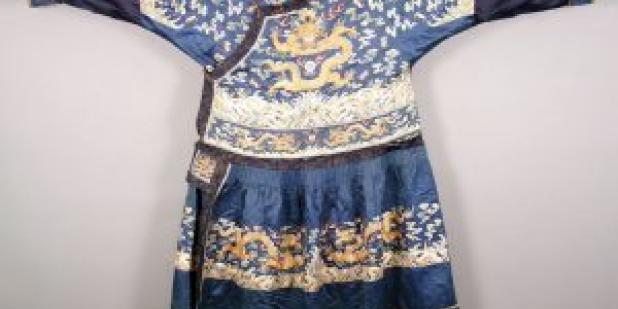Join us for a free one-day workshop for educators at the Japanese American National Museum, hosted by the USC U.S.-China Institute and the National Consortium for Teaching about Asia. This workshop will include a guided tour of the beloved exhibition Common Ground: The Heart of Community, slated to close permanently in January 2025. Following the tour, learn strategies for engaging students in the primary source artifacts, images, and documents found in JANM’s vast collection and discover classroom-ready resources to support teaching and learning about the Japanese American experience.
Ceremonies and Celebrations: Textile Treasures from the USC Pacific Asia Museum Collection
Ceremonies and Celebrations: Textile Treasures from the USC Pacific Asia Museum Collection, drawn from the museum’s extraordinary collection of over 2,700 costumes and textiles from China, Korea, Japan, India, the Himalayas and Southeast Asia. (September 14, 2018 through January 6, 2019)

Textiles are tactile, colorful objects that play an integral role in the lives of people across Asia. They are made with care and display a variety of techniques, colors, and materials that reveal a great deal about the cultures from which they originate. Often times, the processes in which they were made and the motifs embellished into their surfaces directly relate to belief and power in Asian communities. The finest textiles are reserved for ceremonies and celebrations marking special occasions, and specific style, color, or motifs function as visual cues to the nature of such ceremonies, as well as the social status of a person or people involved.
With select examples across Asia, Ceremonies and Celebrations will explore interesting ideas that can connect these vast regions together. The first section focuses on the connection between gender and textile production and the way that textiles are used to identify gender roles in society. The second idea that is explored in the exhibition is the role of textiles as a signifier of one’s status. The third theme looks at textiles worn or used in marking life transitions, including birth, weddings, and death. The final section illustrates the unique relationship between textiles and religions across Asia. Textiles help to identify religious practitioners and add beauty to religious spaces and rituals. By looking at textiles from these perspectives, rather than by their geographical associations, visitors will be able to see the creativity and the diversity of Asian textiles, while connecting meanings behind textiles from vastly different localities, and learn about why these textiles were made with such special cares and used in specific purposes.
Some of the highlights of the exhibition will be the imperial dragon robes worn by China’s emperors and imperial family during the Qing dynasty (1644-1911). These robes feature nine powerful dragons, the symbol of the Emperor, embroidered or woven across the front and back of the silk robes. The yellow robes were the rarest of all, since the color yellow, symbolizing the sun, was worn exclusively by the Emperor. One such yellow robe, worn by the Guangxu Emperor (1875-1908) as a boy, will be on display.
Also included in the exhibition are magnificent whal-ot (wedding robes) from Korea, a promised gift to the museum, and Japanese kimono and kesa (Buddhist priest robes), some dating to the Edo period (1603-1868). From Southeast Asia will be Indonesian ikat-dyed cloth and batik woven textiles, and pineapple-fiber, or Piña cloth from the Philippines. From South Asia and the Himalayan region, will be colorful silk saris and elegant silk robes made for the Moghul court of India in the 18th and 19th centuries, as well as richly decorated costumes from the kingdom of Bhutan in the Himalayas.
Some of the best examples in the USC PAM’s textile collection are rarely exhibited because of their fragile nature and the negative effect of light on the natural dyes used, and Ceremonies and Celebrations will provide visitors with an exceptional glimpse at those rarely seen textile collection. The exhibition will accompany diverse programs, including lectures and demonstrations by Asian textile experts to highlight some of the featured textiles and techniques used and their history and free Family Festival
Photo from the USC Pacific Asia Museum
Featured Articles
Please join us for the Grad Mixer! Hosted by USC Annenberg Office of International Affairs, Enjoy food, drink and conversation with fellow students across USC Annenberg. Graduate students from any field are welcome to join, so it is a great opportunity to meet fellow students with IR/foreign policy-related research topics and interests.
RSVP link: https://forms.gle/1zer188RE9dCS6Ho6
Events
Hosted by USC Annenberg Office of International Affairs, enjoy food, drink and conversation with fellow international students.
Join us for an in-person conversation on Thursday, November 7th at 4pm with author David M. Lampton as he discusses his new book, Living U.S.-China Relations: From Cold War to Cold War. The book examines the history of U.S.-China relations across eight U.S. presidential administrations.




